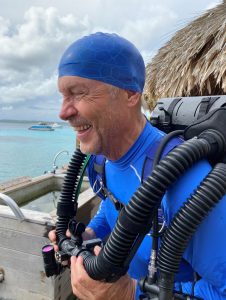Michael Menduno/M2 is an award-winning journalist and technologist who has written about diving and diving technology for more than 30 years. He coined the term “technical diving.” His magazine aquaCORPS: The Journal for Technical Diving (1990-1996), helped usher tech diving into mainstream sports diving and he produced the first tek.Conferences and Rebreather Forums 1.0 & 2.0. Menduno is the co-founder and serves as editor-in-chief of GUE’s InDepth magazine and is an editor/reporter for DAN Europe’s Alert Diver magazine. He is also a contributing editor for X-Ray mag, a staff writer for DeeperBlue.com, sits on the board of the Historical Diving Society (USA), and is a member of the Rebreather Training Council.
How and why do you use checklists?
Ironically, I was introduced to checklists back when technical diving was just getting started in the early 1990s, before it even had a name. I was doing my mixed gas training with Capt. Billy Deans at Key West Diver, Key West Florida, which was arguably the first technical training center on the planet. Billy was ahead of his time; we utilized team diving, standard equipment configurations, and a pre-dive checklist. How else were we going to make sure that everything we needed was there, in working condition and we were ready to make the jump?
I was exposed to checklists again by my first rebreather instructor, Paul Haynes, a former Special Forces instructor, who had become a tech diving instructor. I remember Paul’s opening statement in his class. He held up my AP Evolution rebreather and said, “This machine is going to try and kill you. Your job, and what you will learn in this class, is to not to let it do that.” In Paul’s class, checklists, along with a mouthpiece retaining strap, were two of the means to accomplish that objective. It made good sense to me.
I was introduced to checklists for a third time, when started my GUE training in 2013 with their (open circuit) Fundamentals class. The use of a checklist, in this case the GUE EDGE (Goals, Unified Team, Equipment Match, Exposure, Decompression, Gas and Environment) is standard operating procedure on GUE dives. I know it works because I often catch things that are wrong or missing when I do the checklist, that would have otherwise cause me some stress or worse, problems on the dive. I am the kind of person that is typically juggling n-number of things in my head at any one time—that’s just me—and as a result I find that checklists serve to focus my attention and make sure that I am not about to do something stupid, or forget something, that could hurt me or my team mates. I’m sold on them.
Checklists save lives!

